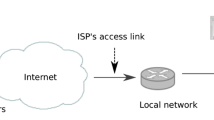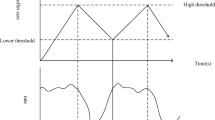Abstract
This paper presents a categorization-based video streaming approach (CVS) to mitigate the Internet traffic in content delivery services. The CVS uses the statistical information related to the users’ view patterns (i.e., the average view duration in accordance with the playback time of the content) to adjust the request period of content chunks. Therefore, it can reduce the amount of Internet traffic by reducing unnecessary chunk requests and content chunks. The operation of the CVS is based on the average view duration provided by the content provider (CP). However, even if the CP does not provide the average view duration of the content, the CVS can properly predict the average view duration by using the content categorization and adjust the request period of content chunks. The simulation results show that the CVS achieves better performance in terms of the average waste ratio of network resources, the amount of network traffic, and the number of chunk requests.








Similar content being viewed by others
References
Apple (2016) HTTP live streaming overview https://developer.apple.com/library/ios/documentation/networkinginternet/conceptual/streamingmediaguide/Introduction/Introduction.html#//apple_ref/doc/uid/TP40008332-CH1-SW1. Accessed 20 Dec 2016
Biernacki A, Tutschku K (2014) Performance of HTTP video streaming under different network conditions. Multimed Tools Appl 72:1143–1166. doi:10.1007/s11042-013-1424-x
Che X, Ip B, Lin L (2015) A survey of current YouTube video characteristics. IEEE Multimedia Mag 22:56–63. doi:10.1109/MMUL.2015.34
Chen L, Qiu M, Dai W, Jiang N (2016) Supporting high-quality video streaming with SDN-based CDNs. J Supercomput. doi:10.1007/s11227-016-1649-3
Cisco (2014–2019) Cisco visual networking index: forecast and methodology
Forouzan BA (2010) Multimedia. In: Srinivasan R (ed) TCP/IP protocol suite, 4th edn. McGraw-Hill, New York, pp 728–766
Kim T, Kim E-J (2015) View pattern-based adaptive streaming strategy for mobile content delivery services. Multimed Tools Appl 75:12693–12704. doi:10.1007/s11042-015-3077-4
Kim T, Kim E-J (2015) Hybrid storage-based caching strategy for content delivery network services. Multimed Tools Appl 74:1697–1709. doi:10.1007/s11042-014-2215-8
Kurose J, Ross K (2013) Multimedia networking. In: Hirsch M (ed) Computer networking: a top-down approach, 6th edn. Pearson, New Jersey, pp 593–611
Ma KJ, Bartos R, Bhatia S, Nair R (2011) Mobile video delivery with HTTP. IEEE Commun Mag 49:166–175. doi:10.1109/MCOM.2011.5741161
Mathew V, Sitaraman RK, Shenoy P (2012) Energy-aware load balancing in content delivery networks. In: 2012 proceedings of IEEE INFOCOM, pp 954–962. doi:10.1109/INFCOM.2012.6195846
Wikipedia (2016) Content delivery network https://en.wikipedia.org/wiki/Content_delivery_network. Accessed 20 Dec 2016
YouTube (2016) YouTube home http://www.youtube.com. Accessed 20 Dec 2016
Yu H (2015) Efficient periodic broadcasting scheme for video delivery over a single channel. Multimed Tools Appl 74:5811–5824. doi:10.1007/s11042-014-1889-2
Zhao D, Qiao K, Yin J, Raicu I (2016) Dynamic virtual chunks: on supporting efficient accesses to compressed scientific data. IEEE Trans Services Comput 9:96–109. doi:10.1109/TSC.2015.2456889
Zhou L (2016) Mobile device-to-device video distribution: theory and application. ACM T Multim Cimput 12:38:1–38:23. doi:10.1145/2886776
Zhou L, Chen M, Qian Y, Chen HH (2013) Fairness resource allocation in blind wireless multimedia communications. IEEE Trans Multimedia 15:946–956. doi:10.1109/TMM.2013.2237895
Zhou W, Huang Y, Yu S, You L, Du Y (2016) Research on the personalised QoE evaluation method for HTTP mobile streaming. Int J Communication Networks and Distributed Systems 16:197–214. doi:10.1504/IJCNDS.2016.076649
Acknowledgments
This research was supported by the Leading Human Resource Training Program of Regional Neo Industry through the National Research Foundation of Korea (NRF) funded by the Ministry of Science, ICT and Future Planning (2016H1D5A1910427). This work was also supported by NRF (National Research Foundation of Korea) Grant funded by the Korean Government (NRF-2016-Fostering Core Leaders of the Future Basic Science Program/Global Ph.D. Fellowship Program) (2016H1A2A1908620).
Author information
Authors and Affiliations
Corresponding author
Rights and permissions
About this article
Cite this article
Kim, TK., Kwon, JH. & Kim, EJ. Categorization-based video streaming for traffic mitigation in content delivery services. Multimed Tools Appl 76, 25495–25510 (2017). https://doi.org/10.1007/s11042-017-4770-2
Received:
Revised:
Accepted:
Published:
Issue Date:
DOI: https://doi.org/10.1007/s11042-017-4770-2




